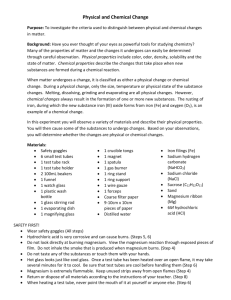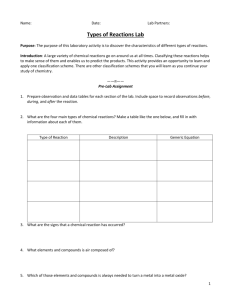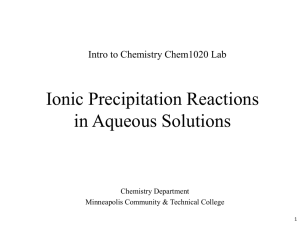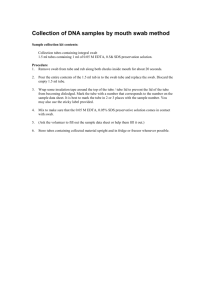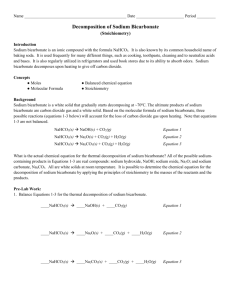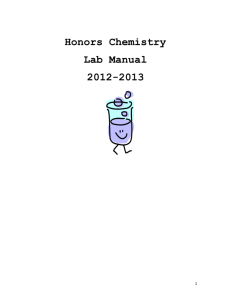PHYSICAL AND CHEMICAL PROPERTIES LAB
advertisement
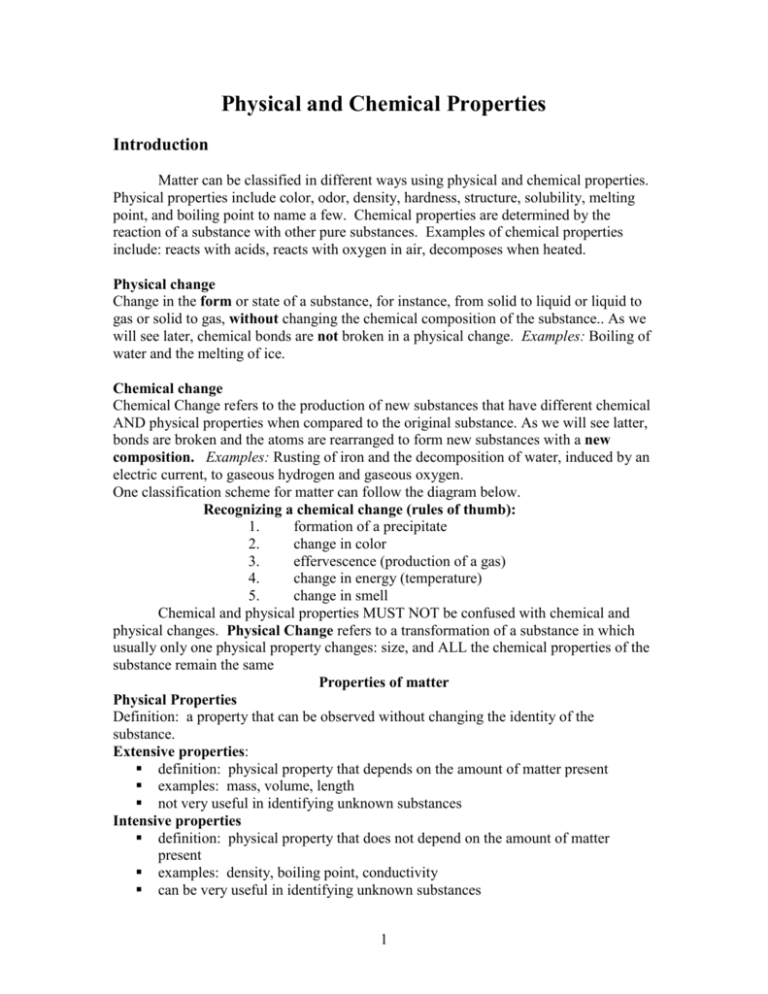
Physical and Chemical Properties Introduction Matter can be classified in different ways using physical and chemical properties. Physical properties include color, odor, density, hardness, structure, solubility, melting point, and boiling point to name a few. Chemical properties are determined by the reaction of a substance with other pure substances. Examples of chemical properties include: reacts with acids, reacts with oxygen in air, decomposes when heated. Physical change Change in the form or state of a substance, for instance, from solid to liquid or liquid to gas or solid to gas, without changing the chemical composition of the substance.. As we will see later, chemical bonds are not broken in a physical change. Examples: Boiling of water and the melting of ice. Chemical change Chemical Change refers to the production of new substances that have different chemical AND physical properties when compared to the original substance. As we will see latter, bonds are broken and the atoms are rearranged to form new substances with a new composition. Examples: Rusting of iron and the decomposition of water, induced by an electric current, to gaseous hydrogen and gaseous oxygen. One classification scheme for matter can follow the diagram below. Recognizing a chemical change (rules of thumb): 1. formation of a precipitate 2. change in color 3. effervescence (production of a gas) 4. change in energy (temperature) 5. change in smell Chemical and physical properties MUST NOT be confused with chemical and physical changes. Physical Change refers to a transformation of a substance in which usually only one physical property changes: size, and ALL the chemical properties of the substance remain the same Properties of matter Physical Properties Definition: a property that can be observed without changing the identity of the substance. Extensive properties: definition: physical property that depends on the amount of matter present examples: mass, volume, length not very useful in identifying unknown substances Intensive properties definition: physical property that does not depend on the amount of matter present examples: density, boiling point, conductivity can be very useful in identifying unknown substances 1 Chemical Properties Definition: a property that can be observed only during a chemical change Examples: reaction with acid, reaction with base, reaction with water, reaction with air In this lab you will investigate the differences between chemical and physical changes in matter. You will be expected to perform several short experiments and observe the changes that occur during each. You will then determine if your procedure resulted in a chemical or physical change and explain why. 2 Purpose To investigate the criteria used to distinguish between physical and chemical changes in matter. Materials Safety goggles Centigram balance 13- Small test tubes Test tube rack Test tube holder 2-100mL beakers Buchner Funnel Assembly Watch Glass Plastic Wash Bottle Glass Stirring Rod Evaporating Dish Magnifying Glass Crucible Tongs Magnet Scoopula Wire Gauze Forceps Fume Hood Exposed Film (Optional) Sulfur powder, S Iron Filings, Fe Sodium bicarbonate, NaHCO3 Sodium chloride, NaCl Sucrose, C12H22O11 Sand Magnesium ribbon, Mg 6M HCl Safety 1. 2. 3. 4. 5. 6. 7. 8. 9. Wear safety glasses at all times during lab Do not look directly at burning magnesium. It can cause cornea damage Do not inhale smoke from burning magnesium 6M HCl is caustic, avoid contact with skin or clothing Do not inhale sulfur powder Do not taste any substances Be aware of hot glassware Keep magnesium strips away from open flames Return or dispose of materials according to teachers instructions Procedure 1.Cut 7- 3x3 squares of notebook paper and label them: sulfur, iron, sodium bicarbonate, sodium chloride, sucrose, sand and magnesium. Obtain pea-sized samples of each substances, collect them on the paper squares. 2. Using the magnifying glass provided, make observations about the texture of each substance. 3. Test the effect of a magnet on each of the 7 substances. Run the magnet under the paper, do not put the magnet directly into the samples. Record your observations. 3 4. Test the solubility of each of the 7 substances in water. Add a small amount of each substance to separate test tubes using the scoopula and add 3 ml of water (use the graduated cylinder to measure) to each test tube. Mix each sample by gently flicking the tube, and/or using a stirring rod. Record your observations. Empty dirty test tubes containing sulfur, iron, and sand in the respective disposal beakers! Do not dump these down the sink. You may empty the test tubes containing sodium chloride, sodium bicarbonate, and sucrose in the sink and clean these test tubes. 5. On a piece of weighing paper mix small amounts of the sulfur and the iron. Move a magnet under the paper. Record your observations. Give the mixture to you teacher for a teacher demonstration at the end of the lab. 6. On another piece of paper combine a small amount of sodium chloride and a small amount of sand. Record your observations. 7. Transfer the sand and salt mixture to a 100 mL beaker and add 30 mL of water. Stir the mixture and make observations. Take the mixture to the sink where the Buchner funnel assembly is located. Place a piece of filter paper in the funnel. Pour the mixtures through the funnel and turn on the water. When the filtration is complete, record observations about the filter paper and throw it in the waste basket. Pour about 10ml of the filtrate into the evaporating dish and return to your lab station. 8. Place the evaporating dish on the ring stand using a clay triangle for support. Using the gas burner, heat the liquid until the water has completely evaporated. Turn off the burner and do not touch the evaporating dish until it has cooled completely. Observe what is inside the evaporating dish. If you need to move it use the tongs. Record your observations. Clean the out the evaporating dish when it is cool. 9. Use the tongs to hold onto one piece of magnesium. Turn on your burner and hold your piece of magnesium into the flame until it ignites. DO NOT LOOK DIRECTLY AT BURNING MAGNESIUM! It produces a blinding light. Catch the combustion product (ashes) on a watch glass. Record your observations. 10. Put the combusted magnesium product into a test tube. Put a new piece of magnesium into another test tube. Carefully add 10 drops of hydrochloric acid to each tube. BE CAREFUL WHEN USING THIS ACID! IT WILL BURN YOUR SKIN AND CLOTHING! Touch the bottom of both test tubes to the palm of your hand. Record your observations. Set test tubes in rack when finished. 11. Put a small amount of sucrose sample into a clean dry test tube. Heat the tube with a flame using a test tube holder and being careful to point the tube away from any people. Watch the tube carefully for changes to the sugar. Record any observations. Be sure that the test tube is cool before touching. 4 12. In a clean dry test tube place a small sample of sodium bicarbonate. Add 10 drops of hydrochloric acid to the test tube. Touch the test tube to the palm of your hand. Record your observations. 13. IMPORTANT Add sodium bicarbonate to both test tubes used on step 9 until the reaction stops. The contents of both tubes can now be rinsed down the drain. 14. Clean your lab station. NOTE: An important part of your lab grade is whether you left your lab station the way you found it, with all glassware cleaned and materials disposed of properly!!!! Teacher Demonstration: Using samples of iron and sulfur mixtures collected from the students in step 5. Put sample in clean dry test tube and find the mass on a centigram balance. Gently burn the mixture in a Bunsen burner flame under a fume hood. Heat more vigorously for 1 minute. Let test tube cool and re mass the substance. Test with a magnet. Have students make observations. Data Table A Physical Properties Substance Texture Sand Magnetic Sodium Chloride Sucrose Sodium bicarbonate Magnesium Iron Sulfur 5 Solubility DATA TABLE 2 Test Iron and sulfur Observations Sand, salt, and water Burning Magnesium Magnesium and HCl Combustion product and HCl Burning sucrose Sodium bicarbonate and HCl Iron and Sulfur burned TEACHER DEMO CONCLUSION/ QUESTIONS: 1. State in your own words the difference between chemical and physical properties. Which parts of this lab showed physical properties and which parts showed chemical properties? 2. State in your own words the difference between chemical and physical changes. For steps 5-12, tell if the changes where chemical or physical and explain why. 3. State in your own words the law of conservation of mass. Where did you see this law exhibited in this lab? You will write a formal report for this lab, using your lab report guidelines. 6
